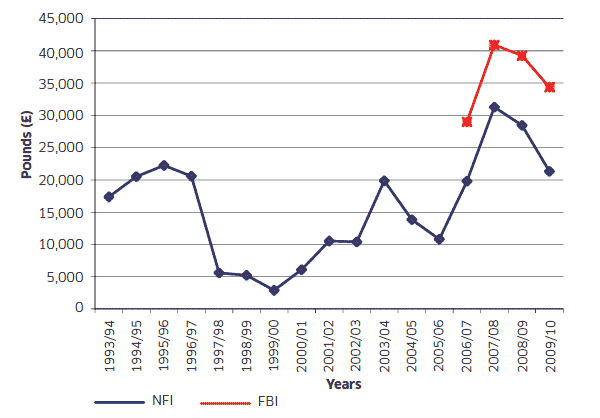Economic Report on Scottish Agriculture 2011 Edition
Invalid description field:Agriculture
This document is part of a collection
Trends in Farm Income
Table B14 and Chart B9 show a time series of average farm income figures. As FBI is only available from 2006/07, the tables and chart show NFI to allow a longer time series. It can be seen that, since its introduction, there has been a fairly constant difference between NFI and FBI. This reflects the fairly constant nature of the factors which account for the differences between the two measures. The increase in the difference in 2009/10 was mainly due to a large fall in net interest payments and an increase in diversified income, both of which increased FBI but did not affect NFI.
Table B14 & Chart B9: Trends in farm incomes (current prices)
Year |
NFI |
FBI |
|---|---|---|
1993/94 |
17,366 |
|
1994/95 |
20,524 |
|
1995/96 |
22,238 |
|
1996/97 |
20,564 |
|
1997/98 |
5,598 |
|
1998/99 |
5,200 |
|
1999/00 |
2,879 |
|
2000/01 |
6,076 |
|
2001/02 |
10,524 |
|
2002/03 |
10,400 |
|
2003/04 |
19,872 |
|
2004/05 |
13,837 |
|
2005/06 |
10,812 |
|
2006/07 |
19,786 |
28,999 |
2007/08 |
31,269 |
40,926 |
2008/09 |
28,453 |
39,271 |
2009/10 |
21,314 |
34,365 |
Chart B9: Trends in farm incomes (current prices)

It can be seen that there has been a great deal of variation in farm incomes in recent years. The big fall in incomes between 1996/97 to 1999/00 was primarily due to a strong pound, weak world commodity prices and the ongoing impact of BSE (with reduced subsidy payments compared to 1996). The figures for 2001/02 do not include farms affected directly by the Foot and Mouth Disease ( FMD) related culling and compensation. This is to avoid presenting a distorted picture of incomes for the vast majority of farms which did not receive FMD compensation. The overall increase from 2005/06 to 2007/08 was driven by an increase in incomes for Cereal, General Cropping and Dairy farms, reflecting the increase in crop prices and milk prices over the period. The decreases in 2008/09 and 2009/10 are due mainly to falls in the income of Cereal and General Cropping farms, reflecting the fall in crop prices from their peak in 2007/08.
Within the overall trends in farm income there are, of course, large variations by farm type. Table B15 and Chart B10 a-h in the appendix show trends in Net Farm Income by farm type, and a comparison with the overall average.
There is a problem
Thanks for your feedback